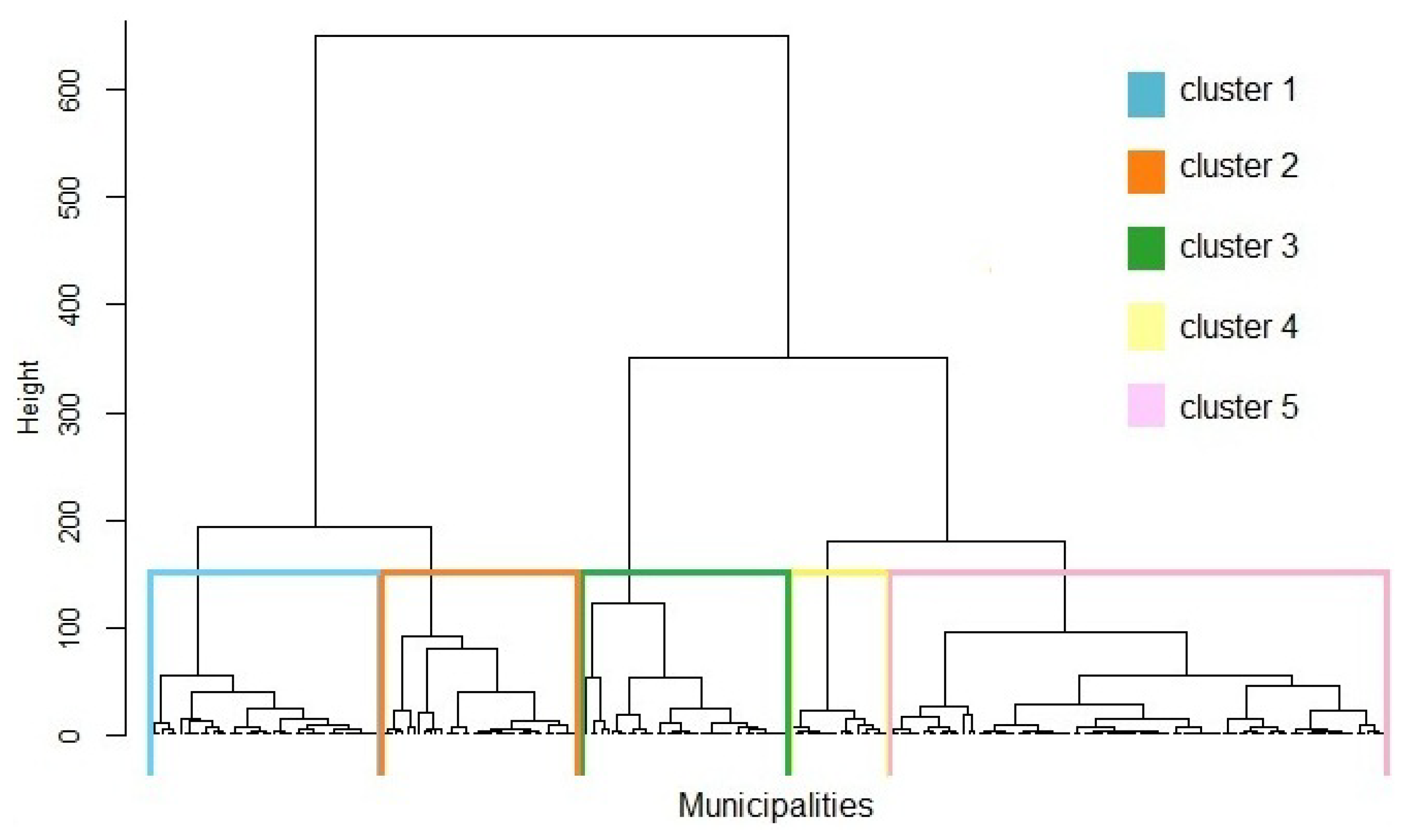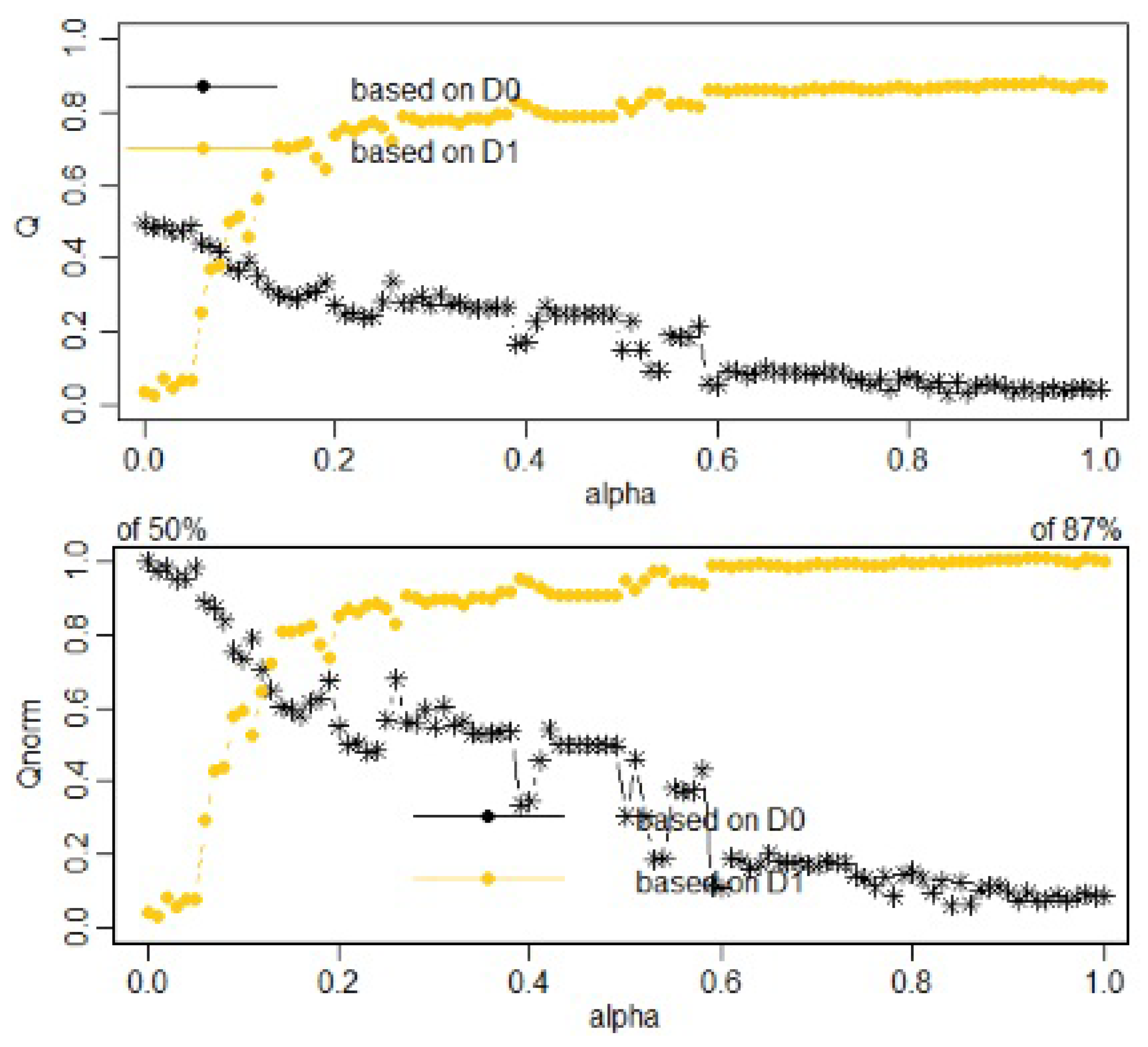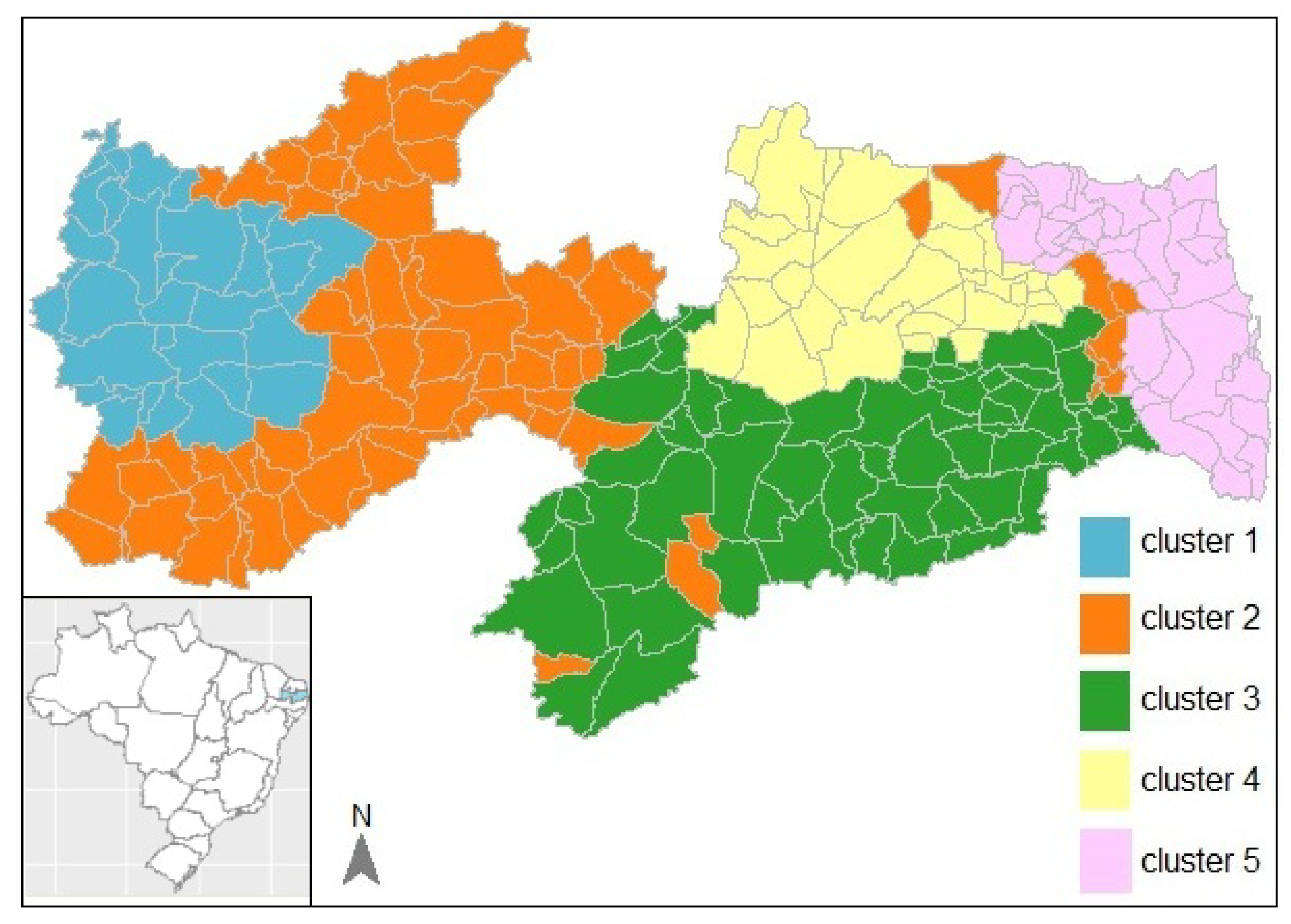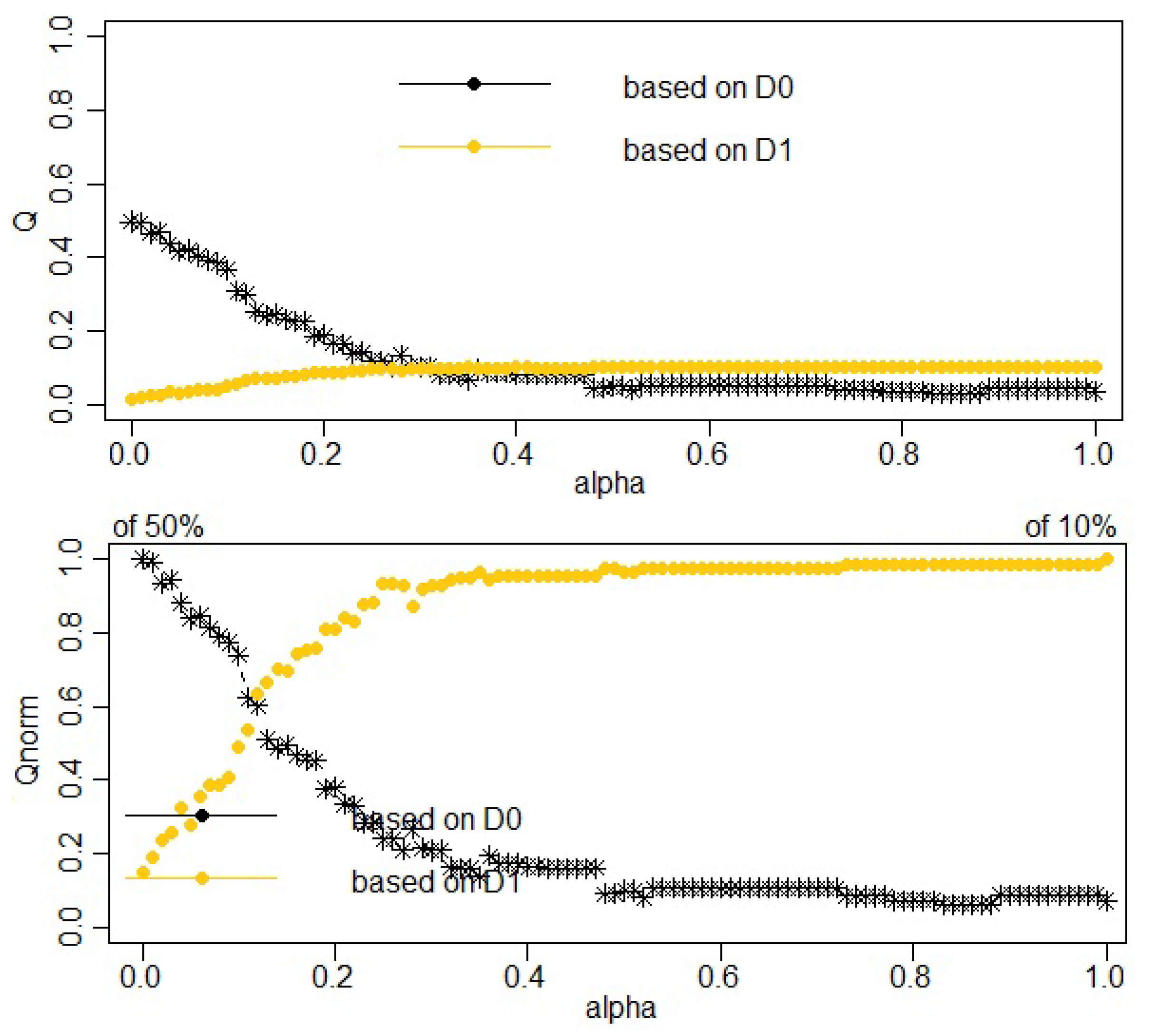Hierarchical Clustering with Spatial Constraints and Standardized Incidence Ratio in Tuberculosis Data
Abstract
:1. Introduction
2. Material and Methods
2.1. Study Design and Data Sources
2.2. Constrained Hierarchical Clustering
2.3. Ward-Like Hierarchical Clustering
2.4. Manhattan Distance
2.5. Standardized Incidence Ratio
3. Results and Discussion
4. Conclusions
Author Contributions
Funding
Conflicts of Interest
Abbreviations
| DATASUS | Department of the Unified Health System |
| IBGE | Brazilian Institute of Geography and Statistics |
| SIR | standardized incidence ratio |
| TB | tuberculosis |
| WHO | World Health Organization |
Appendix A
References
- Vandewalle, V. Multi-Partitions Subspace Clustering. Mathematics 2020, 8, 597. [Google Scholar] [CrossRef] [Green Version]
- Wierzchoń, S.T.; Kłopotek, M.A. Cluster Analysis. In Modern Algorithms of Cluster Analysis; Janusz, K., Ed.; Springer International Publishing AG: Cham, Switzerland, 2018; pp. 9–66. [Google Scholar]
- Chavent, M.; Kuentz-Simonet, V.; Labenne, A.; Saracco, J. ClustGeo: Hierarchical Clustering with Spatial Constraints, R Package Version 2.0; 2017. Available online: https://CRAN.R-project.org/package=ClustGeo (accessed on 17 May 2020).
- WHO—World Health Organization. Global Tuberculosis Report 2019; World Health Organization: Geneva, Switzerland, 2019. [Google Scholar]
- Reis-Santos, B.; Shete, P.; Bertolde, A.; Sales, C.M.; Sanchez, M.N.; Arakaki-Sanchez, D.; Andrade, K.B.; Gomes, M.G.M.; Boccia, D.; Lienhardt, C.; et al. Tuberculosis in Brazil and Cash Transfer Programs: A Longitudinal Database Study of the Effect of Cash Transfer on Cure Rates. PLoS ONE 2019, 14, e0212617. [Google Scholar] [CrossRef] [PubMed] [Green Version]
- World Health Organization. Global Tuberculosis Report 2017; World Health Organization: Geneva, Switzerland, 2017. [Google Scholar]
- Ministério da Saúde. Brasil Livre da Tuberculose: Evolução dos Cenários Epidemiológicos e Operacionais da Doença; Boletim Epidemiológico; Secretaria de Vigilância em Saúde: Brasília, Brasil, March 2019; Volume 50.
- Aguiar, D.C.; Silva Camelo, E.L.; Carneiro, R.O. Análise estatística de indicadores da tuberculose no Estado da Paraíba. Rev. Aten. Saúde. 2019, 17, 5–12. [Google Scholar]
- IBGE. Instituto brasileiro de geografia e Estatística. In Paraíba–Panorama; 2019. Available online: https://cidades.ibge.gov.br (accessed on 8 May 2020).
- Santos Neto, M.; Sousa, M.R.; da Silva, F.B.G.; Santos, F.S.; Ferreira, A.G.N.; Pascoal, L.M.; Costa, A.C.P.d.; Bezerra, J.M.; Serra, M.A.A.d.O.; Dias, I.C.C.M.; et al. Spatial distribution of tuberculosis cases in a priority Brazilian northeast municipality for control of the disease. Int. J. Dev. Res. 2017, 7, 10611. [Google Scholar]
- Moraga, P. Small Area Disease Risk Estimation and Visualization Using R. R J. 2018, 10, 495–506. [Google Scholar] [CrossRef] [Green Version]
- SINAN. Sistema de Informação de Agravos de Notificação. In Tuberculose–Casos Confirmados; Ministério da Saúde, Brazil: Brasília, Barzil, 2020. Available online: http://www2.datasus.gov.br/ (accessed on 5 April 2020).
- R Core Team. R: A Language and Environment for Statistical Computing; R Foundation for Statistical Computing: Vienna, Austria, 2019; Available online: https://www.R-project.org/ (accessed on 15 May 2020).
- Duque, J.C.; Dev, B.; Betancourt, A.; Franco, J.L. ClusterPy: Library of Spatially Constrained Clustering Algorithms, RiSE-Group (Research in Spatial Economics). 2011. Version 0.9.9; Available online: http://www.rise-group.org/risem/clusterpy/ (accessed on 15 May 2020).
- Bécue-Bertaut, M.; Alvarez-Esteban, R.; Sánchez-Espigares, J.A. Xplortext: Statistical Analysis of Textual Data R Package, R Package Version 1.0. 2017. Version 0.9.9; Available online: https://cran.r-project.org/package=Xplortext (accessed on 7 June 2020).
- Dehman, A.; Ambroise, C.; Neuvial, P. Performance of a blockwise approach in variable selection using linkage disequilibrium information. BMC Bioinform. 2015, 16, 148. [Google Scholar] [CrossRef] [PubMed] [Green Version]
- Legendre, P. const.clust: Space-and Time-Constrained Clustering Package. R Package Version 1.2. 2011. Available online: http://adn.biol.umontreal.ca/numericalecology/Rcode/ (accessed on 20 May 2020).
- Ambroise, C.; Govaert, G. Convergence of an EM-type algorithm for spatial clustering. Pattern Recognit. Lett. 1998, 19, 919–927. [Google Scholar] [CrossRef]
- Ambroise, C.; Dang, M.; Govaert, G. Clustering of Spatial Data by the EM Algorithm. In geoENV I-Geostatistics for Environmental Applicattions; Soares, A.O., Gomez-Hernandez, J.J., Froidevaux, R., Eds.; Kluwer: Dordrecht, The Netherland, 1997; pp. 493–504. [Google Scholar]
- Aguiar, D.C.; Sánchez, R.G.; Silva Camêlo, E.L. Hierarchical clustering with spatial constraints in tuberculosis data. IJDR 2020, 10, 35374–35380. [Google Scholar]
- Aguiar, D.C.; Sánchez, R.G.; Silva Camêlo, E.L. Ward-like hierarchical clustering with dissimilarities and non-uniform weights in cases of tuberculosis in Paraíba, Brazil. IJDR 2020, 10, 35478–35483. [Google Scholar]
- Miele, V.; Picard, F.; Dray, S. Spatially constrained clustering of ecological networks. Methods Ecol. Evol. 2014, 5, 771–779. [Google Scholar] [CrossRef]
- Chavent, M.; Kuentz-Simonet, V.; Labenne, A.; Saracco, J. ClustGeo: An R package for hierarchical clustering with spatial constraints. Comput. Stat. 2018, 33, 1799–1822. [Google Scholar] [CrossRef] [Green Version]
- Majure, J.J.; Gebhardt, A. sgeostat: An Object-Oriented Framework for Geostatistical Modeling in S+, R Package Version 1.0-27; 2016. Available online: https://CRAN.R-project.org/package=sgeostat (accessed on 7 June 2020).
- Hijmans, R.J. Geosphere: Spherical Trigonometry, R Package Version 1.5-10; 2019. Available online: https://CRAN.R-project.org/package=geosphere (accessed on 7 June 2020).
- Wallace, J.R. Imap: Interactive Mapping, R Package Version 1.32; 2012. Available online: https://CRAN.R-project.org/package=Imap (accessed on 7 June 2020).
- Strauss, T.; von Maltitz, M.J. Generalising Ward’s Method for Use with Manhattan Distances. PLoS ONE 2017, 12, e0168288. [Google Scholar] [CrossRef] [PubMed] [Green Version]






| Alpha Values | Q0norm | Q1norm |
|---|---|---|
| = 0.16 | 0.57808701 | 0.81167272 |
| = 0.17 | 0.61407565 | 0.82247147 |
| = 0.18 | 0.62478207 | 0.77433402 |
| = 0.19 | 0.67296737 | 0.73850413 |
| = 0.20 | 0.54877711 | 0.84948899 |
© 2020 by the authors. Licensee MDPI, Basel, Switzerland. This article is an open access article distributed under the terms and conditions of the Creative Commons Attribution (CC BY) license (http://creativecommons.org/licenses/by/4.0/).
Share and Cite
Camêlo Aguiar, D.; Gutiérrez Sánchez, R.; Silva Camêlo, E.L. Hierarchical Clustering with Spatial Constraints and Standardized Incidence Ratio in Tuberculosis Data. Mathematics 2020, 8, 1478. https://doi.org/10.3390/math8091478
Camêlo Aguiar D, Gutiérrez Sánchez R, Silva Camêlo EL. Hierarchical Clustering with Spatial Constraints and Standardized Incidence Ratio in Tuberculosis Data. Mathematics. 2020; 8(9):1478. https://doi.org/10.3390/math8091478
Chicago/Turabian StyleCamêlo Aguiar, Dalila, Ramón Gutiérrez Sánchez, and Edwirde Luiz Silva Camêlo. 2020. "Hierarchical Clustering with Spatial Constraints and Standardized Incidence Ratio in Tuberculosis Data" Mathematics 8, no. 9: 1478. https://doi.org/10.3390/math8091478
APA StyleCamêlo Aguiar, D., Gutiérrez Sánchez, R., & Silva Camêlo, E. L. (2020). Hierarchical Clustering with Spatial Constraints and Standardized Incidence Ratio in Tuberculosis Data. Mathematics, 8(9), 1478. https://doi.org/10.3390/math8091478






